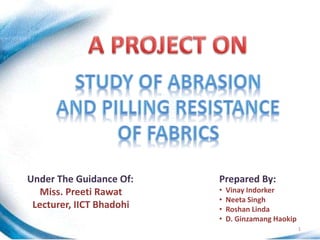
Projectpresentation 121108113314-phpapp02
- 1. Under The Guidance Of: Miss. Preeti Rawat Lecturer, IICT Bhadohi Prepared By: • • • • Vinay Indorker Neeta Singh Roshan Linda D. Ginzamang Haokip 1
- 2. Abrasion Resistance • ASTM D123 describes Abrasion Resistance as follows: “The wearing away of any part of a material by rubbing against another surface.” • A fabric can be abraded by: 1. As a fabric rubs on another fabric. 2. As a fabric rubs against another object. 3. As fibers or yarns within the fabric rub against each other when the fabric bends, flexes, or stretches. 4. As dust, grit, or other particles held within the fabric rub against fibers inside the fabric. 2
- 3. Pilling Resistance • Pilling is defined as the condition that arises in wear due to the formation of little 'pills' of entangled fibre clinging to the fabric surface giving it an unsightly appearance. • The pills are formed during wearing and washing by the entanglement of the loose fibres which protrude from the fabric surface. • Pilling takes place when the fabric has been subjected to abrasion. 3
- 4. Factors affecting abrasion resistance 1. Fibre type 2. Yarn type 3. Fabric Weave Criteria for the evaluation of abrasion Resistance a) Overall appearance and loss in colour or shade, signs of damaged yarns, fibers and so on. b) Loss in the breaking strength of the specimen. c) Loss in the weight of the specimen. d) Decrease in the thickness of the specimen. e) Change in the air permeability of the specimen. 4
- 5. Areas where Abrasion resistant fabrics are used: • • • • • • • In wood strip kayaks In Pocket Lining fabric. In upholsteries. Private aviation / marine In Bed-Spreads Seat covers in Vehicles In Rope Coatings. 5
- 6. Factors affecting pilling 1. • • 2. • • 3. • • Fibre properties: Fibre rigidity Fibre strength Yarn properties: Higher twist, less pilling More compact yarn, less pilling Fabric properties: More compact the fabric structure, lower pilling Tightness factor 6
- 7. Assessment of Pilling • Pills observed in worn garments vary appreciably in size and appearance . • Loss of cover. • Colour change. • Development of fuzz. Machines Used: • • • • Sample Warping Machine Sample Weaving Loom Martindale Abrasion Tester ICI Pill Box 7
- 8. Material Used • A 300 denier draw Textured PET yarn was brought from the market. • Actual Yarn Count: 303 Denier 8
- 9. Experimental Work • Winding - Cone winding machine. - Manufactured by Rajesh Industries • Warping - Model SW550 - Working Width 20 inches maximum - Air Consumption 10L/mm. Air pressure 6-9kgf/cm2 - Power 220V Single phase, 50-60Hz 9
- 10. • Weaving - Rapier weaving machine - Model : SL8900s - Weaving width: 20 inches maximum - Speed: 45 ppm maximum - Weft Insertion :Single rapier weft insertion driven by servomotor. - Controller PC based controller/Window operating system • Testing - Abrasion Testing: Martindale Abrasion Tester - Pilling Tester: ICI Pill Box 10
- 11. Abrasion Testing • Standard abradant fabric - IWS recommended cloth SM25 - Mounted over a piece of woven or non-woven felt - Mass of the felt should be 750 +/- 50g and approximately 2 mm thick • Conditioning of test specimens - Conditioning is Done at 65% +/- 2% R.H., 27° C +/-2 as defined in BS 1051 11
- 12. Preparation of test specimens • Four specimens each cut or punched 38 mm in diameter are mounted Testing • Two samples warp wise and two samples weft-wise • Take Weight loss readings: - W1 ………… Initial Weight of the Sample - W2…………Weight of the sample after 10,000 cycles - W3…………Weight of the samples after 20,000 cycles - W4…………Weight of the sample after 40,000 cycles 12
- 13. Pilling Test • Consists of either 2 or 4 drums or boxes • The tester features a counter which stops the machine after a predetermined number of revolutions. • Polyurethane tubes, 4 for each box. These are each 140 mm long and 31.5 mm in outer diameter. Testing • Two samples warp wise and two samples weft-wise • Test readings were taken. • Grading is Done. 13
- 15. Results • For Abrasion testing: 2/2 Twill > 3/1 Twill > Crepe > Satin - From Abrasion tesing: Satin weave has the poorest Abrasion Resistance while 2/2 twill has the best • For Pilling Testing: 2/2 Twill > 3/1 Twill > Crepe > Satin - From Pilling tesing: Satin weave is prone to pill formation while 2/2 twill is least. 15
- 16. References • Principle of Textile Testing by J. E. Booth. Chapter No. 7. Page No. 309 • Textile science by E. P. Gohl and L. D. Vilensky.Chapter No. 5. Page No. 112-113 • Physical testing of textiles by Seville. Page No. 185-200 • Article on “Abrasion Resistance: the full story” and “Abrasion Resistance: Consideration for textile specifiers”. http://www.contracttextiles.org/page.jsp?navigation=38 • The art of manipulating fabric. www.isotextileblogspot.com • Fabric testing, Woodhead Publishing Limited, 2008. • Instruction manual for the SDL 235 Martindale Abrasion tester. • Instruction manual for the M227B Pilling Box SDL. 16
- 17. References(Continued…) • Fabric structure and Design by N. Gokarneshan. Chapter No. 4 & 7. Page No.22-36; 45-49. • Chapter 14 Abrasion and Pilling http://www.qdu.edu.cn/chapter_14_Abrasion_and_Pilling • Heavy duty fabrics an essay by W. W. Informational page from http://www.ahh.biz/specialized_textiles_outfitters • http://www.heavydutyfabric.com • Manual of CCI TECH INC, Sample Warping Machine. • Manual of CCI TECH INC, Sample Weaving Machine. • Effect of Abrasion, Crease recovery, Tensile Strength, and Hydrophilic Properties of Contemporary Cotton/ Synthetic Fibre Blends By Mrs. Samia Kalsoom. Page No. 71- 86. 17
